Analysis of Nestle's Business Environment, Stakeholders, and Policies
VerifiedAdded on 2019/12/28
|13
|4243
|190
Report
AI Summary
This report provides a comprehensive analysis of Nestle's business environment, examining various aspects crucial to its operations. It begins with an introduction to the business environment and the company profile of Nestle, a Swiss multinational food and beverage giant. The report then delves into an essay analyzing economic systems, resource allocation, and the role of public and private initiatives. A case study is presented, focusing on organizational purpose, stakeholder objectives, and corporate social responsibility. The study further assesses the impact of fiscal and monetary policies on the business and explores market structures, pricing, and the influence of cultural environments. The report also addresses the significance of international trade, the impact of global factors and the European Union on Nestle's operations, culminating in a comprehensive conclusion and a list of references.
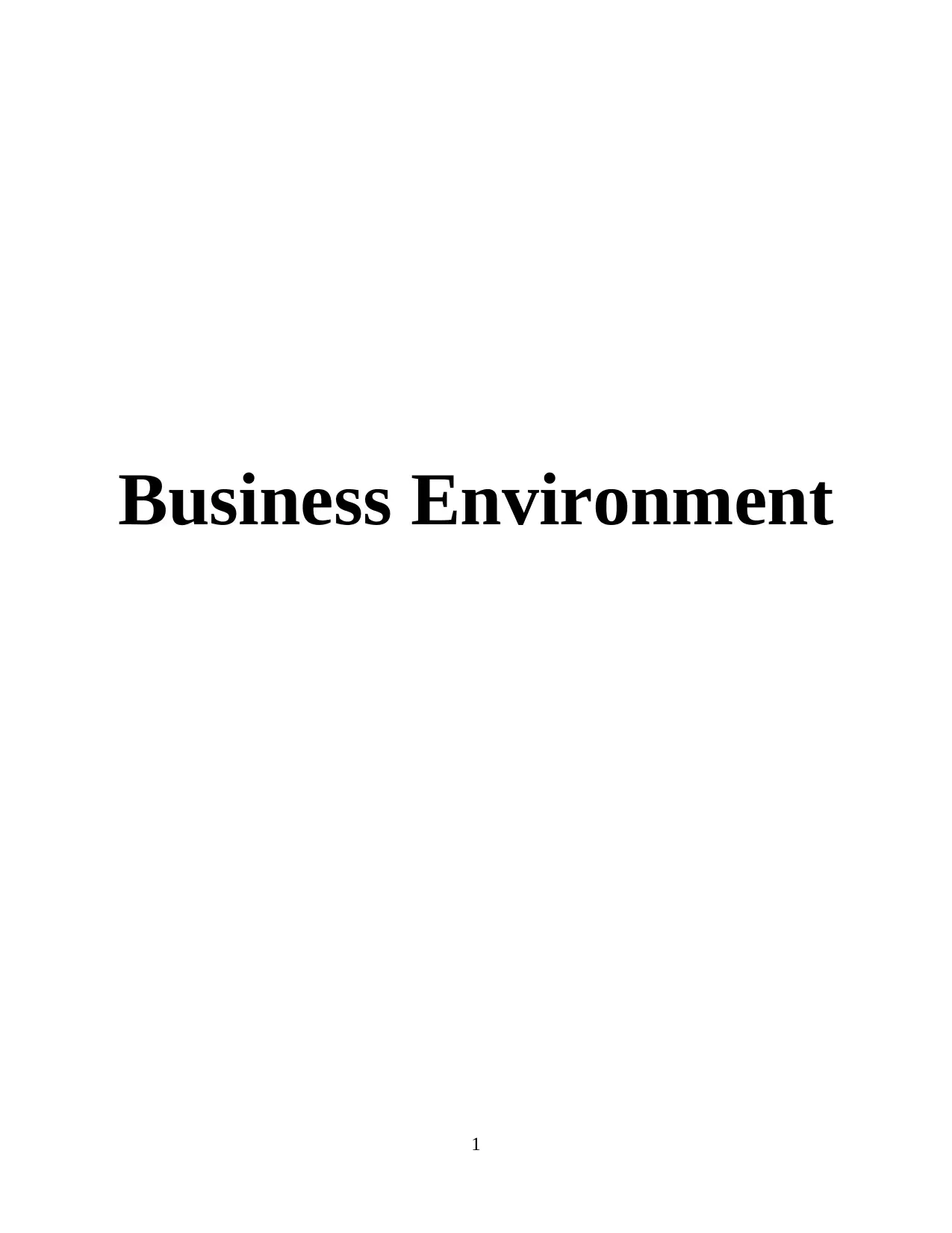
Business Environment
1
1
Paraphrase This Document
Need a fresh take? Get an instant paraphrase of this document with our AI Paraphraser
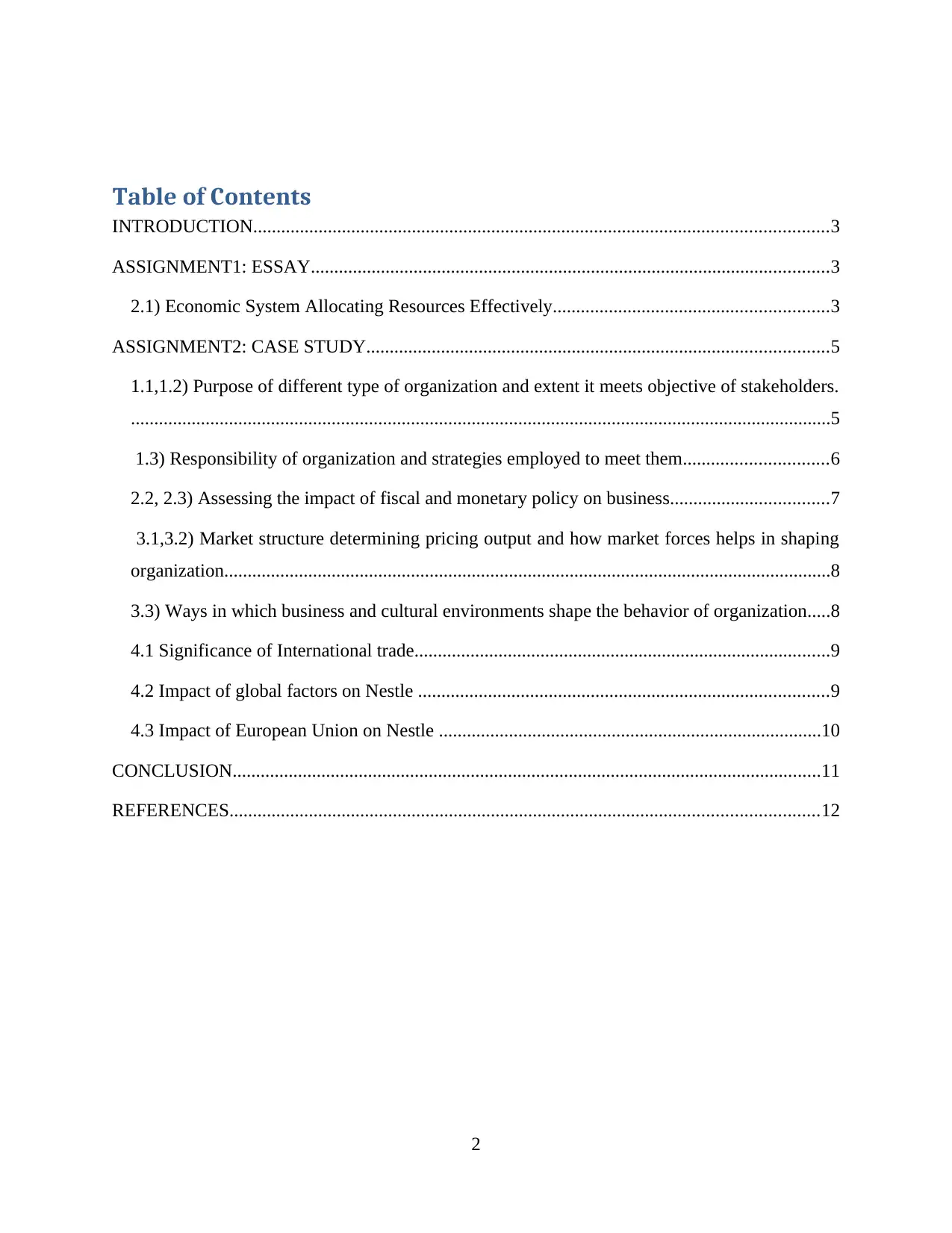
Table of Contents
INTRODUCTION...........................................................................................................................3
ASSIGNMENT1: ESSAY...............................................................................................................3
2.1) Economic System Allocating Resources Effectively...........................................................3
ASSIGNMENT2: CASE STUDY...................................................................................................5
1.1,1.2) Purpose of different type of organization and extent it meets objective of stakeholders.
......................................................................................................................................................5
1.3) Responsibility of organization and strategies employed to meet them...............................6
2.2, 2.3) Assessing the impact of fiscal and monetary policy on business..................................7
3.1,3.2) Market structure determining pricing output and how market forces helps in shaping
organization..................................................................................................................................8
3.3) Ways in which business and cultural environments shape the behavior of organization.....8
4.1 Significance of International trade.........................................................................................9
4.2 Impact of global factors on Nestle ........................................................................................9
4.3 Impact of European Union on Nestle ..................................................................................10
CONCLUSION..............................................................................................................................11
REFERENCES..............................................................................................................................12
2
INTRODUCTION...........................................................................................................................3
ASSIGNMENT1: ESSAY...............................................................................................................3
2.1) Economic System Allocating Resources Effectively...........................................................3
ASSIGNMENT2: CASE STUDY...................................................................................................5
1.1,1.2) Purpose of different type of organization and extent it meets objective of stakeholders.
......................................................................................................................................................5
1.3) Responsibility of organization and strategies employed to meet them...............................6
2.2, 2.3) Assessing the impact of fiscal and monetary policy on business..................................7
3.1,3.2) Market structure determining pricing output and how market forces helps in shaping
organization..................................................................................................................................8
3.3) Ways in which business and cultural environments shape the behavior of organization.....8
4.1 Significance of International trade.........................................................................................9
4.2 Impact of global factors on Nestle ........................................................................................9
4.3 Impact of European Union on Nestle ..................................................................................10
CONCLUSION..............................................................................................................................11
REFERENCES..............................................................................................................................12
2
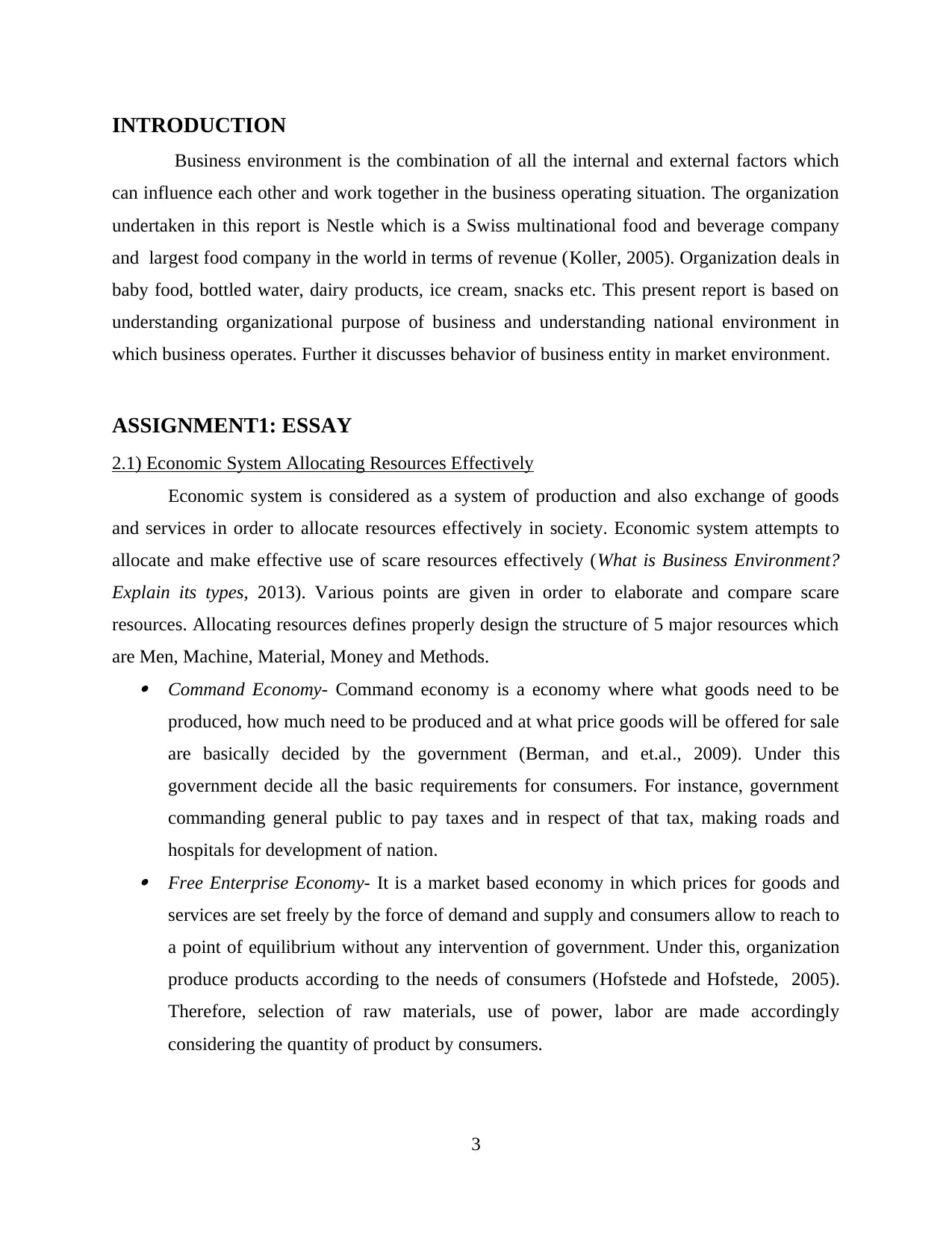
INTRODUCTION
Business environment is the combination of all the internal and external factors which
can influence each other and work together in the business operating situation. The organization
undertaken in this report is Nestle which is a Swiss multinational food and beverage company
and largest food company in the world in terms of revenue (Koller, 2005). Organization deals in
baby food, bottled water, dairy products, ice cream, snacks etc. This present report is based on
understanding organizational purpose of business and understanding national environment in
which business operates. Further it discusses behavior of business entity in market environment.
ASSIGNMENT1: ESSAY
2.1) Economic System Allocating Resources Effectively
Economic system is considered as a system of production and also exchange of goods
and services in order to allocate resources effectively in society. Economic system attempts to
allocate and make effective use of scare resources effectively (What is Business Environment?
Explain its types, 2013). Various points are given in order to elaborate and compare scare
resources. Allocating resources defines properly design the structure of 5 major resources which
are Men, Machine, Material, Money and Methods. Command Economy- Command economy is a economy where what goods need to be
produced, how much need to be produced and at what price goods will be offered for sale
are basically decided by the government (Berman, and et.al., 2009). Under this
government decide all the basic requirements for consumers. For instance, government
commanding general public to pay taxes and in respect of that tax, making roads and
hospitals for development of nation. Free Enterprise Economy- It is a market based economy in which prices for goods and
services are set freely by the force of demand and supply and consumers allow to reach to
a point of equilibrium without any intervention of government. Under this, organization
produce products according to the needs of consumers (Hofstede and Hofstede, 2005).
Therefore, selection of raw materials, use of power, labor are made accordingly
considering the quantity of product by consumers.
3
Business environment is the combination of all the internal and external factors which
can influence each other and work together in the business operating situation. The organization
undertaken in this report is Nestle which is a Swiss multinational food and beverage company
and largest food company in the world in terms of revenue (Koller, 2005). Organization deals in
baby food, bottled water, dairy products, ice cream, snacks etc. This present report is based on
understanding organizational purpose of business and understanding national environment in
which business operates. Further it discusses behavior of business entity in market environment.
ASSIGNMENT1: ESSAY
2.1) Economic System Allocating Resources Effectively
Economic system is considered as a system of production and also exchange of goods
and services in order to allocate resources effectively in society. Economic system attempts to
allocate and make effective use of scare resources effectively (What is Business Environment?
Explain its types, 2013). Various points are given in order to elaborate and compare scare
resources. Allocating resources defines properly design the structure of 5 major resources which
are Men, Machine, Material, Money and Methods. Command Economy- Command economy is a economy where what goods need to be
produced, how much need to be produced and at what price goods will be offered for sale
are basically decided by the government (Berman, and et.al., 2009). Under this
government decide all the basic requirements for consumers. For instance, government
commanding general public to pay taxes and in respect of that tax, making roads and
hospitals for development of nation. Free Enterprise Economy- It is a market based economy in which prices for goods and
services are set freely by the force of demand and supply and consumers allow to reach to
a point of equilibrium without any intervention of government. Under this, organization
produce products according to the needs of consumers (Hofstede and Hofstede, 2005).
Therefore, selection of raw materials, use of power, labor are made accordingly
considering the quantity of product by consumers.
3
⊘ This is a preview!⊘
Do you want full access?
Subscribe today to unlock all pages.

Trusted by 1+ million students worldwide
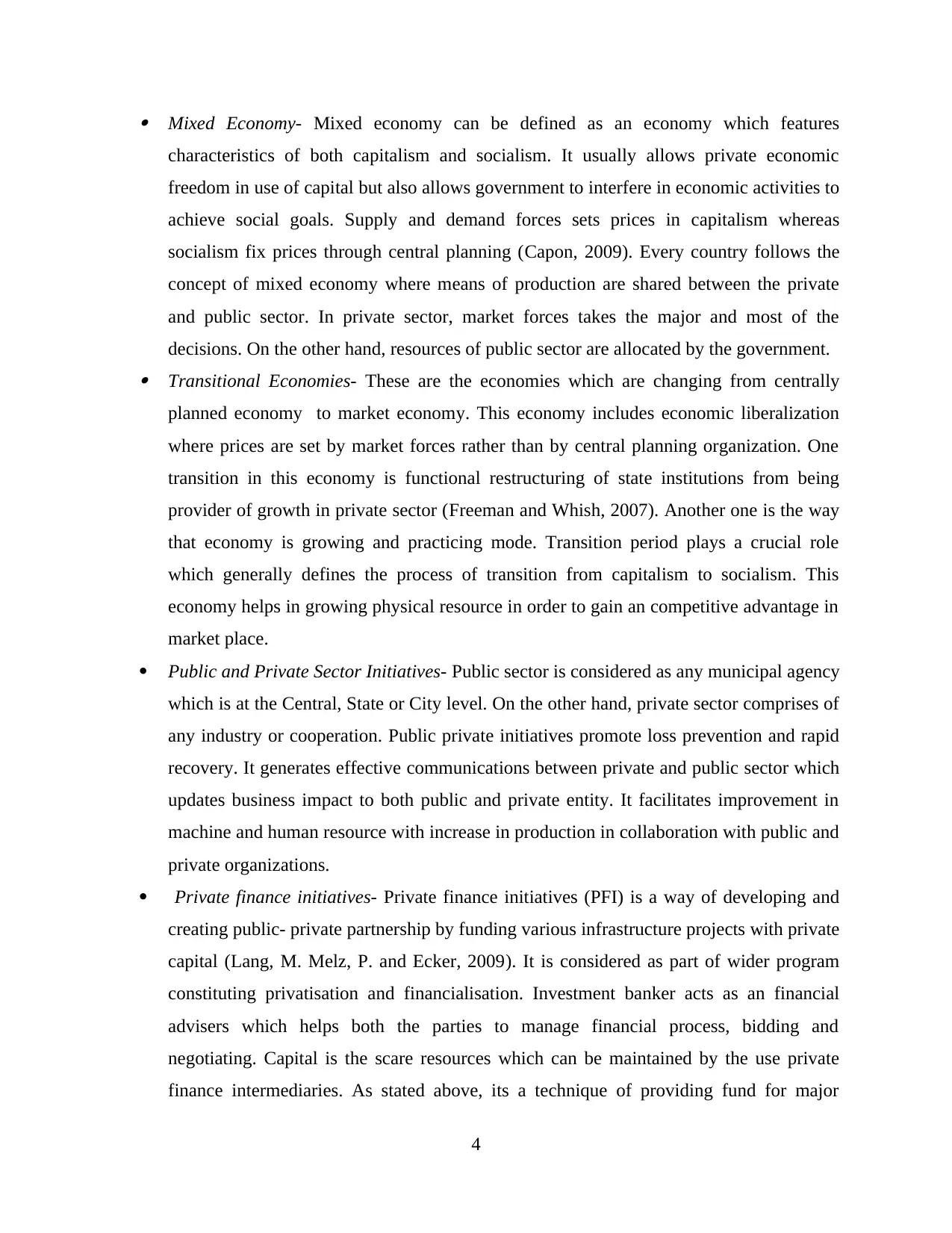
Mixed Economy- Mixed economy can be defined as an economy which features
characteristics of both capitalism and socialism. It usually allows private economic
freedom in use of capital but also allows government to interfere in economic activities to
achieve social goals. Supply and demand forces sets prices in capitalism whereas
socialism fix prices through central planning (Capon, 2009). Every country follows the
concept of mixed economy where means of production are shared between the private
and public sector. In private sector, market forces takes the major and most of the
decisions. On the other hand, resources of public sector are allocated by the government. Transitional Economies- These are the economies which are changing from centrally
planned economy to market economy. This economy includes economic liberalization
where prices are set by market forces rather than by central planning organization. One
transition in this economy is functional restructuring of state institutions from being
provider of growth in private sector (Freeman and Whish, 2007). Another one is the way
that economy is growing and practicing mode. Transition period plays a crucial role
which generally defines the process of transition from capitalism to socialism. This
economy helps in growing physical resource in order to gain an competitive advantage in
market place.
Public and Private Sector Initiatives- Public sector is considered as any municipal agency
which is at the Central, State or City level. On the other hand, private sector comprises of
any industry or cooperation. Public private initiatives promote loss prevention and rapid
recovery. It generates effective communications between private and public sector which
updates business impact to both public and private entity. It facilitates improvement in
machine and human resource with increase in production in collaboration with public and
private organizations.
Private finance initiatives- Private finance initiatives (PFI) is a way of developing and
creating public- private partnership by funding various infrastructure projects with private
capital (Lang, M. Melz, P. and Ecker, 2009). It is considered as part of wider program
constituting privatisation and financialisation. Investment banker acts as an financial
advisers which helps both the parties to manage financial process, bidding and
negotiating. Capital is the scare resources which can be maintained by the use private
finance intermediaries. As stated above, its a technique of providing fund for major
4
characteristics of both capitalism and socialism. It usually allows private economic
freedom in use of capital but also allows government to interfere in economic activities to
achieve social goals. Supply and demand forces sets prices in capitalism whereas
socialism fix prices through central planning (Capon, 2009). Every country follows the
concept of mixed economy where means of production are shared between the private
and public sector. In private sector, market forces takes the major and most of the
decisions. On the other hand, resources of public sector are allocated by the government. Transitional Economies- These are the economies which are changing from centrally
planned economy to market economy. This economy includes economic liberalization
where prices are set by market forces rather than by central planning organization. One
transition in this economy is functional restructuring of state institutions from being
provider of growth in private sector (Freeman and Whish, 2007). Another one is the way
that economy is growing and practicing mode. Transition period plays a crucial role
which generally defines the process of transition from capitalism to socialism. This
economy helps in growing physical resource in order to gain an competitive advantage in
market place.
Public and Private Sector Initiatives- Public sector is considered as any municipal agency
which is at the Central, State or City level. On the other hand, private sector comprises of
any industry or cooperation. Public private initiatives promote loss prevention and rapid
recovery. It generates effective communications between private and public sector which
updates business impact to both public and private entity. It facilitates improvement in
machine and human resource with increase in production in collaboration with public and
private organizations.
Private finance initiatives- Private finance initiatives (PFI) is a way of developing and
creating public- private partnership by funding various infrastructure projects with private
capital (Lang, M. Melz, P. and Ecker, 2009). It is considered as part of wider program
constituting privatisation and financialisation. Investment banker acts as an financial
advisers which helps both the parties to manage financial process, bidding and
negotiating. Capital is the scare resources which can be maintained by the use private
finance intermediaries. As stated above, its a technique of providing fund for major
4
Paraphrase This Document
Need a fresh take? Get an instant paraphrase of this document with our AI Paraphraser
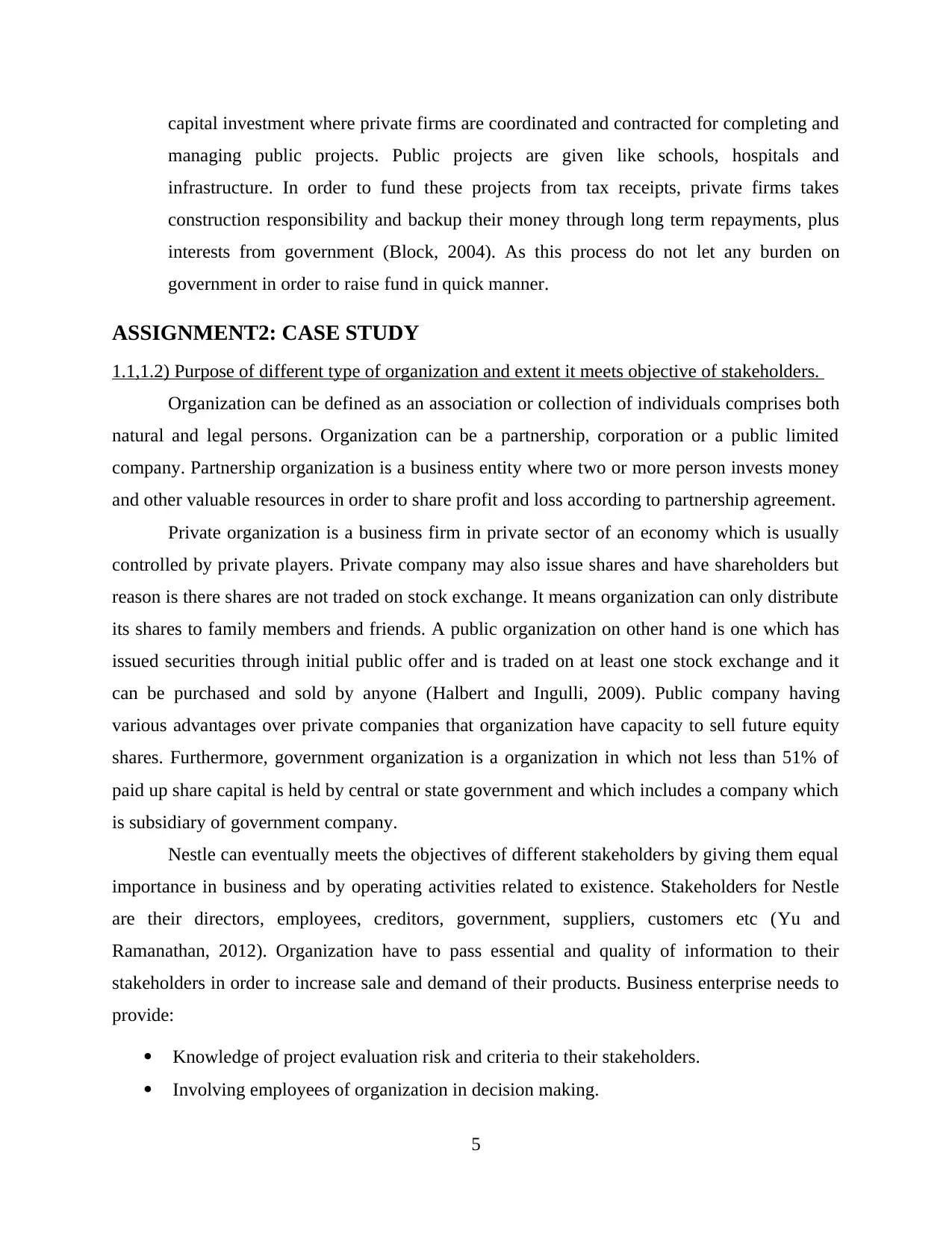
capital investment where private firms are coordinated and contracted for completing and
managing public projects. Public projects are given like schools, hospitals and
infrastructure. In order to fund these projects from tax receipts, private firms takes
construction responsibility and backup their money through long term repayments, plus
interests from government (Block, 2004). As this process do not let any burden on
government in order to raise fund in quick manner.
ASSIGNMENT2: CASE STUDY
1.1,1.2) Purpose of different type of organization and extent it meets objective of stakeholders.
Organization can be defined as an association or collection of individuals comprises both
natural and legal persons. Organization can be a partnership, corporation or a public limited
company. Partnership organization is a business entity where two or more person invests money
and other valuable resources in order to share profit and loss according to partnership agreement.
Private organization is a business firm in private sector of an economy which is usually
controlled by private players. Private company may also issue shares and have shareholders but
reason is there shares are not traded on stock exchange. It means organization can only distribute
its shares to family members and friends. A public organization on other hand is one which has
issued securities through initial public offer and is traded on at least one stock exchange and it
can be purchased and sold by anyone (Halbert and Ingulli, 2009). Public company having
various advantages over private companies that organization have capacity to sell future equity
shares. Furthermore, government organization is a organization in which not less than 51% of
paid up share capital is held by central or state government and which includes a company which
is subsidiary of government company.
Nestle can eventually meets the objectives of different stakeholders by giving them equal
importance in business and by operating activities related to existence. Stakeholders for Nestle
are their directors, employees, creditors, government, suppliers, customers etc (Yu and
Ramanathan, 2012). Organization have to pass essential and quality of information to their
stakeholders in order to increase sale and demand of their products. Business enterprise needs to
provide:
Knowledge of project evaluation risk and criteria to their stakeholders.
Involving employees of organization in decision making.
5
managing public projects. Public projects are given like schools, hospitals and
infrastructure. In order to fund these projects from tax receipts, private firms takes
construction responsibility and backup their money through long term repayments, plus
interests from government (Block, 2004). As this process do not let any burden on
government in order to raise fund in quick manner.
ASSIGNMENT2: CASE STUDY
1.1,1.2) Purpose of different type of organization and extent it meets objective of stakeholders.
Organization can be defined as an association or collection of individuals comprises both
natural and legal persons. Organization can be a partnership, corporation or a public limited
company. Partnership organization is a business entity where two or more person invests money
and other valuable resources in order to share profit and loss according to partnership agreement.
Private organization is a business firm in private sector of an economy which is usually
controlled by private players. Private company may also issue shares and have shareholders but
reason is there shares are not traded on stock exchange. It means organization can only distribute
its shares to family members and friends. A public organization on other hand is one which has
issued securities through initial public offer and is traded on at least one stock exchange and it
can be purchased and sold by anyone (Halbert and Ingulli, 2009). Public company having
various advantages over private companies that organization have capacity to sell future equity
shares. Furthermore, government organization is a organization in which not less than 51% of
paid up share capital is held by central or state government and which includes a company which
is subsidiary of government company.
Nestle can eventually meets the objectives of different stakeholders by giving them equal
importance in business and by operating activities related to existence. Stakeholders for Nestle
are their directors, employees, creditors, government, suppliers, customers etc (Yu and
Ramanathan, 2012). Organization have to pass essential and quality of information to their
stakeholders in order to increase sale and demand of their products. Business enterprise needs to
provide:
Knowledge of project evaluation risk and criteria to their stakeholders.
Involving employees of organization in decision making.
5
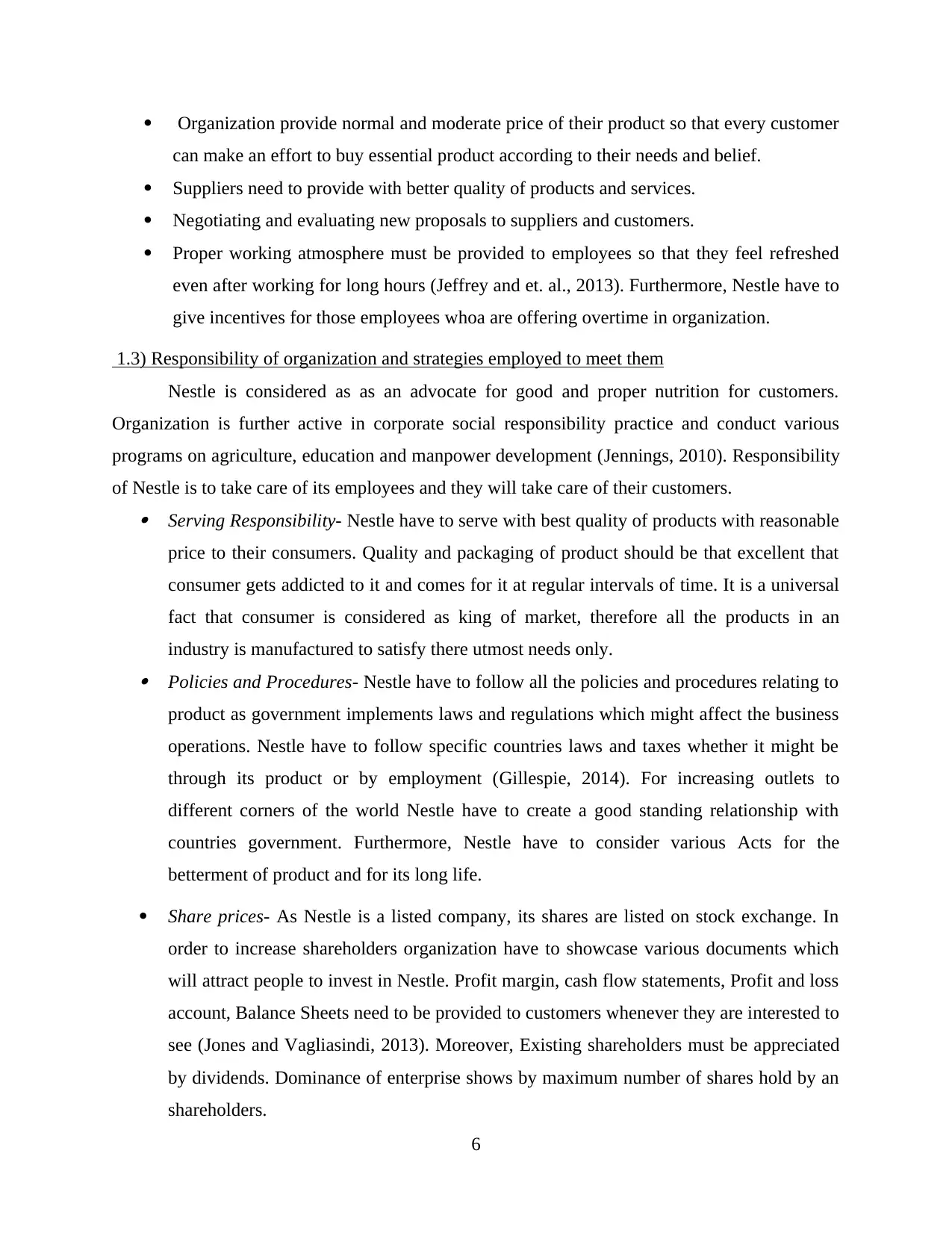
Organization provide normal and moderate price of their product so that every customer
can make an effort to buy essential product according to their needs and belief.
Suppliers need to provide with better quality of products and services.
Negotiating and evaluating new proposals to suppliers and customers.
Proper working atmosphere must be provided to employees so that they feel refreshed
even after working for long hours (Jeffrey and et. al., 2013). Furthermore, Nestle have to
give incentives for those employees whoa are offering overtime in organization.
1.3) Responsibility of organization and strategies employed to meet them
Nestle is considered as as an advocate for good and proper nutrition for customers.
Organization is further active in corporate social responsibility practice and conduct various
programs on agriculture, education and manpower development (Jennings, 2010). Responsibility
of Nestle is to take care of its employees and they will take care of their customers. Serving Responsibility- Nestle have to serve with best quality of products with reasonable
price to their consumers. Quality and packaging of product should be that excellent that
consumer gets addicted to it and comes for it at regular intervals of time. It is a universal
fact that consumer is considered as king of market, therefore all the products in an
industry is manufactured to satisfy there utmost needs only. Policies and Procedures- Nestle have to follow all the policies and procedures relating to
product as government implements laws and regulations which might affect the business
operations. Nestle have to follow specific countries laws and taxes whether it might be
through its product or by employment (Gillespie, 2014). For increasing outlets to
different corners of the world Nestle have to create a good standing relationship with
countries government. Furthermore, Nestle have to consider various Acts for the
betterment of product and for its long life.
Share prices- As Nestle is a listed company, its shares are listed on stock exchange. In
order to increase shareholders organization have to showcase various documents which
will attract people to invest in Nestle. Profit margin, cash flow statements, Profit and loss
account, Balance Sheets need to be provided to customers whenever they are interested to
see (Jones and Vagliasindi, 2013). Moreover, Existing shareholders must be appreciated
by dividends. Dominance of enterprise shows by maximum number of shares hold by an
shareholders.
6
can make an effort to buy essential product according to their needs and belief.
Suppliers need to provide with better quality of products and services.
Negotiating and evaluating new proposals to suppliers and customers.
Proper working atmosphere must be provided to employees so that they feel refreshed
even after working for long hours (Jeffrey and et. al., 2013). Furthermore, Nestle have to
give incentives for those employees whoa are offering overtime in organization.
1.3) Responsibility of organization and strategies employed to meet them
Nestle is considered as as an advocate for good and proper nutrition for customers.
Organization is further active in corporate social responsibility practice and conduct various
programs on agriculture, education and manpower development (Jennings, 2010). Responsibility
of Nestle is to take care of its employees and they will take care of their customers. Serving Responsibility- Nestle have to serve with best quality of products with reasonable
price to their consumers. Quality and packaging of product should be that excellent that
consumer gets addicted to it and comes for it at regular intervals of time. It is a universal
fact that consumer is considered as king of market, therefore all the products in an
industry is manufactured to satisfy there utmost needs only. Policies and Procedures- Nestle have to follow all the policies and procedures relating to
product as government implements laws and regulations which might affect the business
operations. Nestle have to follow specific countries laws and taxes whether it might be
through its product or by employment (Gillespie, 2014). For increasing outlets to
different corners of the world Nestle have to create a good standing relationship with
countries government. Furthermore, Nestle have to consider various Acts for the
betterment of product and for its long life.
Share prices- As Nestle is a listed company, its shares are listed on stock exchange. In
order to increase shareholders organization have to showcase various documents which
will attract people to invest in Nestle. Profit margin, cash flow statements, Profit and loss
account, Balance Sheets need to be provided to customers whenever they are interested to
see (Jones and Vagliasindi, 2013). Moreover, Existing shareholders must be appreciated
by dividends. Dominance of enterprise shows by maximum number of shares hold by an
shareholders.
6
⊘ This is a preview!⊘
Do you want full access?
Subscribe today to unlock all pages.

Trusted by 1+ million students worldwide
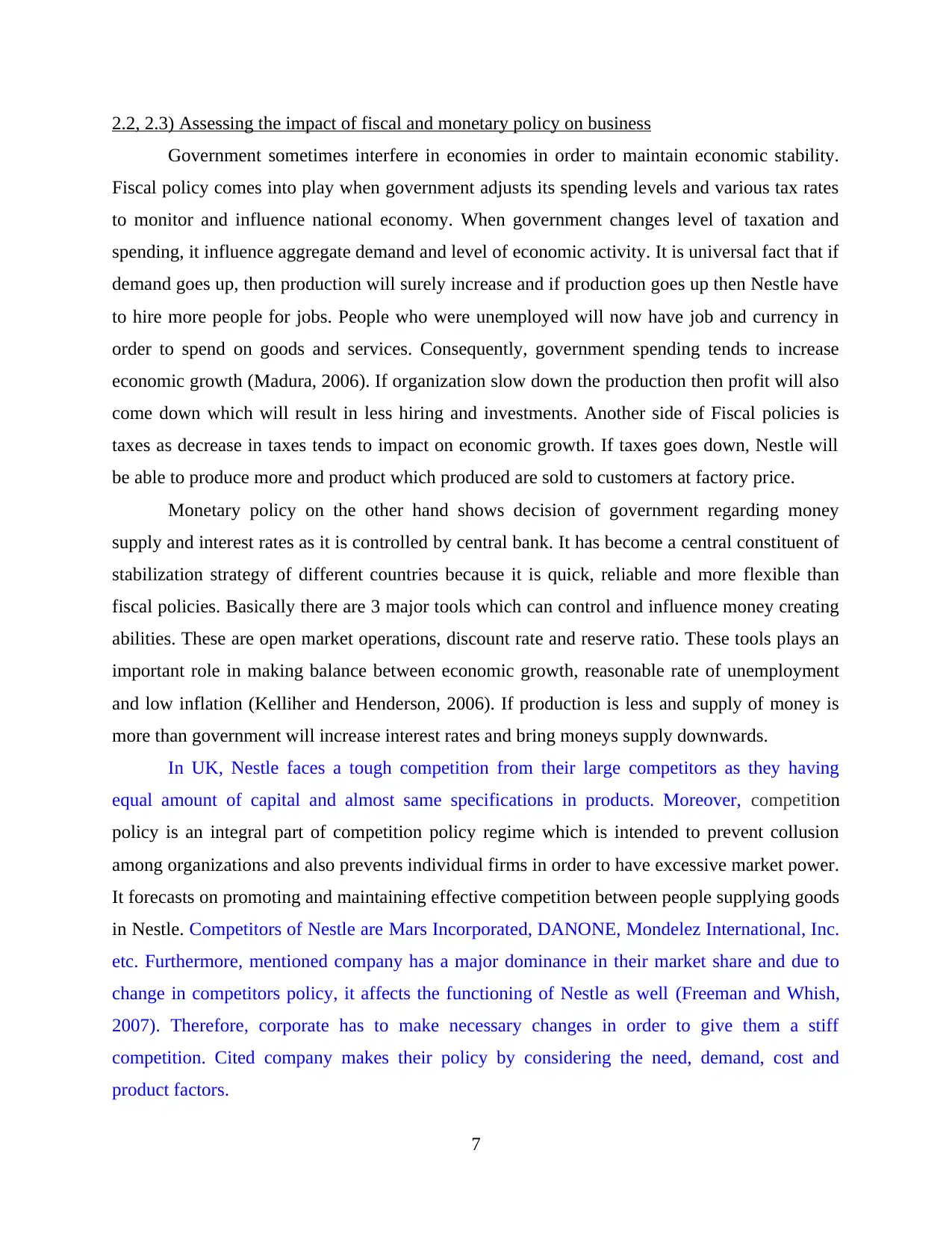
2.2, 2.3) Assessing the impact of fiscal and monetary policy on business
Government sometimes interfere in economies in order to maintain economic stability.
Fiscal policy comes into play when government adjusts its spending levels and various tax rates
to monitor and influence national economy. When government changes level of taxation and
spending, it influence aggregate demand and level of economic activity. It is universal fact that if
demand goes up, then production will surely increase and if production goes up then Nestle have
to hire more people for jobs. People who were unemployed will now have job and currency in
order to spend on goods and services. Consequently, government spending tends to increase
economic growth (Madura, 2006). If organization slow down the production then profit will also
come down which will result in less hiring and investments. Another side of Fiscal policies is
taxes as decrease in taxes tends to impact on economic growth. If taxes goes down, Nestle will
be able to produce more and product which produced are sold to customers at factory price.
Monetary policy on the other hand shows decision of government regarding money
supply and interest rates as it is controlled by central bank. It has become a central constituent of
stabilization strategy of different countries because it is quick, reliable and more flexible than
fiscal policies. Basically there are 3 major tools which can control and influence money creating
abilities. These are open market operations, discount rate and reserve ratio. These tools plays an
important role in making balance between economic growth, reasonable rate of unemployment
and low inflation (Kelliher and Henderson, 2006). If production is less and supply of money is
more than government will increase interest rates and bring moneys supply downwards.
In UK, Nestle faces a tough competition from their large competitors as they having
equal amount of capital and almost same specifications in products. Moreover, competition
policy is an integral part of competition policy regime which is intended to prevent collusion
among organizations and also prevents individual firms in order to have excessive market power.
It forecasts on promoting and maintaining effective competition between people supplying goods
in Nestle. Competitors of Nestle are Mars Incorporated, DANONE, Mondelez International, Inc.
etc. Furthermore, mentioned company has a major dominance in their market share and due to
change in competitors policy, it affects the functioning of Nestle as well (Freeman and Whish,
2007). Therefore, corporate has to make necessary changes in order to give them a stiff
competition. Cited company makes their policy by considering the need, demand, cost and
product factors.
7
Government sometimes interfere in economies in order to maintain economic stability.
Fiscal policy comes into play when government adjusts its spending levels and various tax rates
to monitor and influence national economy. When government changes level of taxation and
spending, it influence aggregate demand and level of economic activity. It is universal fact that if
demand goes up, then production will surely increase and if production goes up then Nestle have
to hire more people for jobs. People who were unemployed will now have job and currency in
order to spend on goods and services. Consequently, government spending tends to increase
economic growth (Madura, 2006). If organization slow down the production then profit will also
come down which will result in less hiring and investments. Another side of Fiscal policies is
taxes as decrease in taxes tends to impact on economic growth. If taxes goes down, Nestle will
be able to produce more and product which produced are sold to customers at factory price.
Monetary policy on the other hand shows decision of government regarding money
supply and interest rates as it is controlled by central bank. It has become a central constituent of
stabilization strategy of different countries because it is quick, reliable and more flexible than
fiscal policies. Basically there are 3 major tools which can control and influence money creating
abilities. These are open market operations, discount rate and reserve ratio. These tools plays an
important role in making balance between economic growth, reasonable rate of unemployment
and low inflation (Kelliher and Henderson, 2006). If production is less and supply of money is
more than government will increase interest rates and bring moneys supply downwards.
In UK, Nestle faces a tough competition from their large competitors as they having
equal amount of capital and almost same specifications in products. Moreover, competition
policy is an integral part of competition policy regime which is intended to prevent collusion
among organizations and also prevents individual firms in order to have excessive market power.
It forecasts on promoting and maintaining effective competition between people supplying goods
in Nestle. Competitors of Nestle are Mars Incorporated, DANONE, Mondelez International, Inc.
etc. Furthermore, mentioned company has a major dominance in their market share and due to
change in competitors policy, it affects the functioning of Nestle as well (Freeman and Whish,
2007). Therefore, corporate has to make necessary changes in order to give them a stiff
competition. Cited company makes their policy by considering the need, demand, cost and
product factors.
7
Paraphrase This Document
Need a fresh take? Get an instant paraphrase of this document with our AI Paraphraser
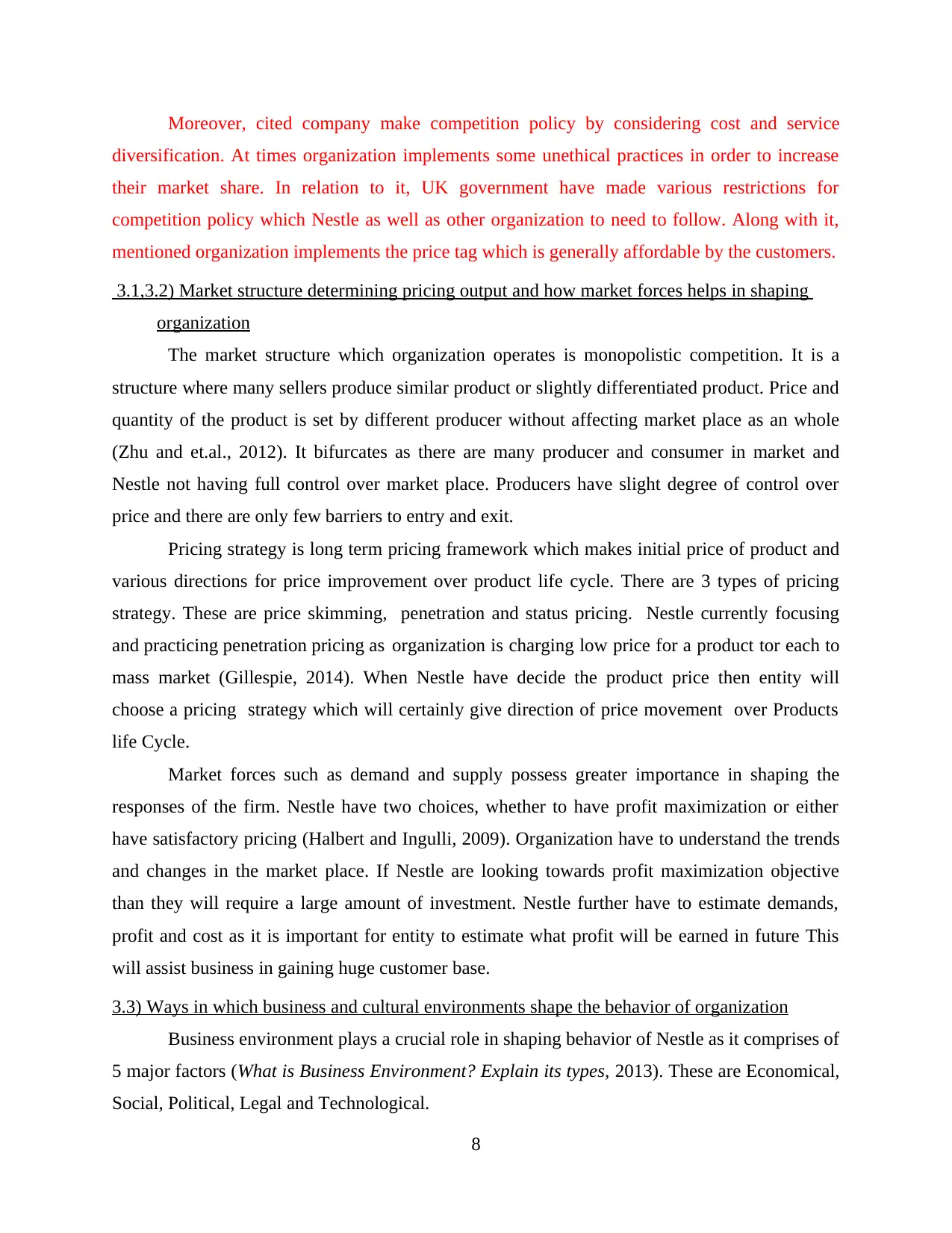
Moreover, cited company make competition policy by considering cost and service
diversification. At times organization implements some unethical practices in order to increase
their market share. In relation to it, UK government have made various restrictions for
competition policy which Nestle as well as other organization to need to follow. Along with it,
mentioned organization implements the price tag which is generally affordable by the customers.
3.1,3.2) Market structure determining pricing output and how market forces helps in shaping
organization
The market structure which organization operates is monopolistic competition. It is a
structure where many sellers produce similar product or slightly differentiated product. Price and
quantity of the product is set by different producer without affecting market place as an whole
(Zhu and et.al., 2012). It bifurcates as there are many producer and consumer in market and
Nestle not having full control over market place. Producers have slight degree of control over
price and there are only few barriers to entry and exit.
Pricing strategy is long term pricing framework which makes initial price of product and
various directions for price improvement over product life cycle. There are 3 types of pricing
strategy. These are price skimming, penetration and status pricing. Nestle currently focusing
and practicing penetration pricing as organization is charging low price for a product tor each to
mass market (Gillespie, 2014). When Nestle have decide the product price then entity will
choose a pricing strategy which will certainly give direction of price movement over Products
life Cycle.
Market forces such as demand and supply possess greater importance in shaping the
responses of the firm. Nestle have two choices, whether to have profit maximization or either
have satisfactory pricing (Halbert and Ingulli, 2009). Organization have to understand the trends
and changes in the market place. If Nestle are looking towards profit maximization objective
than they will require a large amount of investment. Nestle further have to estimate demands,
profit and cost as it is important for entity to estimate what profit will be earned in future This
will assist business in gaining huge customer base.
3.3) Ways in which business and cultural environments shape the behavior of organization
Business environment plays a crucial role in shaping behavior of Nestle as it comprises of
5 major factors (What is Business Environment? Explain its types, 2013). These are Economical,
Social, Political, Legal and Technological.
8
diversification. At times organization implements some unethical practices in order to increase
their market share. In relation to it, UK government have made various restrictions for
competition policy which Nestle as well as other organization to need to follow. Along with it,
mentioned organization implements the price tag which is generally affordable by the customers.
3.1,3.2) Market structure determining pricing output and how market forces helps in shaping
organization
The market structure which organization operates is monopolistic competition. It is a
structure where many sellers produce similar product or slightly differentiated product. Price and
quantity of the product is set by different producer without affecting market place as an whole
(Zhu and et.al., 2012). It bifurcates as there are many producer and consumer in market and
Nestle not having full control over market place. Producers have slight degree of control over
price and there are only few barriers to entry and exit.
Pricing strategy is long term pricing framework which makes initial price of product and
various directions for price improvement over product life cycle. There are 3 types of pricing
strategy. These are price skimming, penetration and status pricing. Nestle currently focusing
and practicing penetration pricing as organization is charging low price for a product tor each to
mass market (Gillespie, 2014). When Nestle have decide the product price then entity will
choose a pricing strategy which will certainly give direction of price movement over Products
life Cycle.
Market forces such as demand and supply possess greater importance in shaping the
responses of the firm. Nestle have two choices, whether to have profit maximization or either
have satisfactory pricing (Halbert and Ingulli, 2009). Organization have to understand the trends
and changes in the market place. If Nestle are looking towards profit maximization objective
than they will require a large amount of investment. Nestle further have to estimate demands,
profit and cost as it is important for entity to estimate what profit will be earned in future This
will assist business in gaining huge customer base.
3.3) Ways in which business and cultural environments shape the behavior of organization
Business environment plays a crucial role in shaping behavior of Nestle as it comprises of
5 major factors (What is Business Environment? Explain its types, 2013). These are Economical,
Social, Political, Legal and Technological.
8
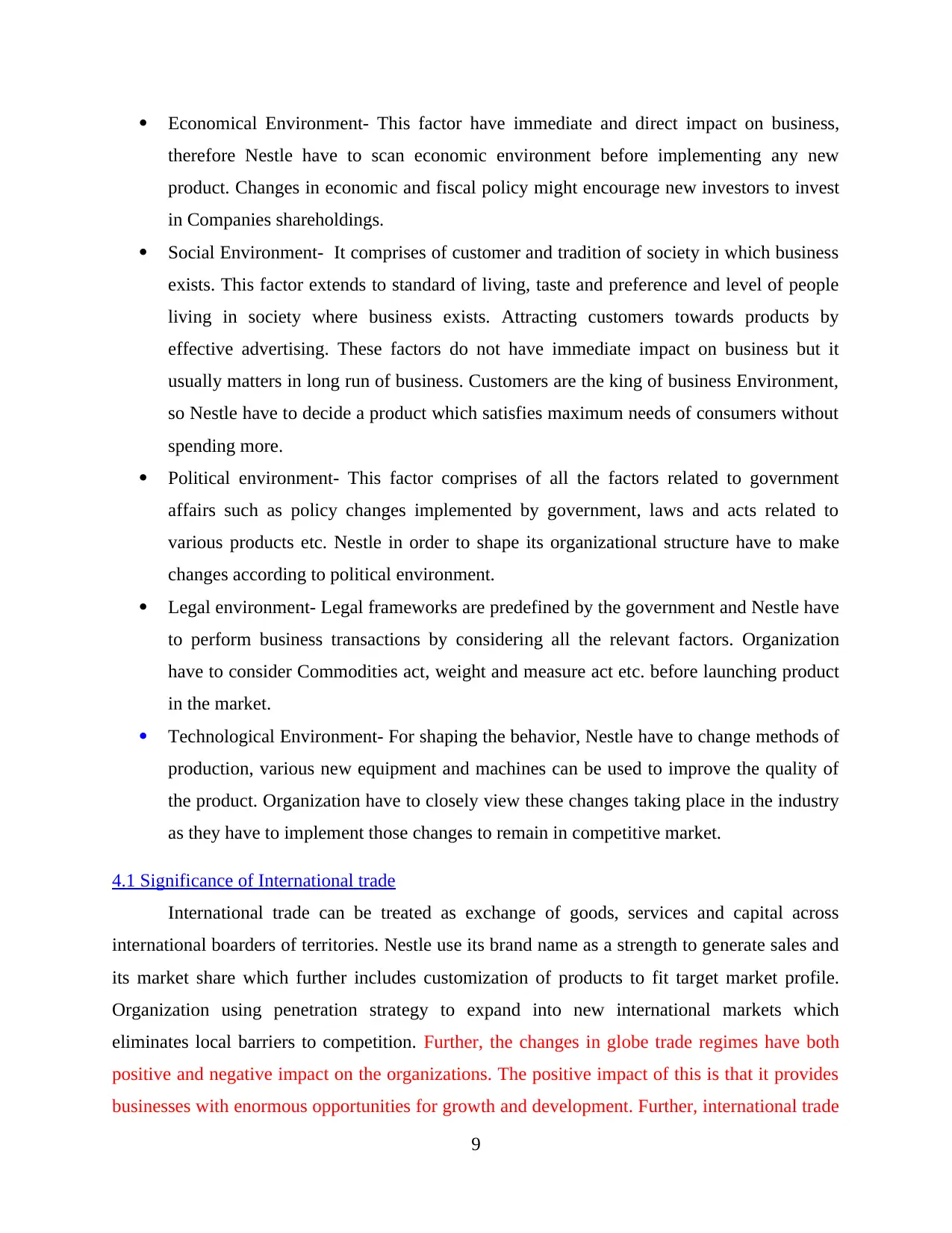
Economical Environment- This factor have immediate and direct impact on business,
therefore Nestle have to scan economic environment before implementing any new
product. Changes in economic and fiscal policy might encourage new investors to invest
in Companies shareholdings.
Social Environment- It comprises of customer and tradition of society in which business
exists. This factor extends to standard of living, taste and preference and level of people
living in society where business exists. Attracting customers towards products by
effective advertising. These factors do not have immediate impact on business but it
usually matters in long run of business. Customers are the king of business Environment,
so Nestle have to decide a product which satisfies maximum needs of consumers without
spending more.
Political environment- This factor comprises of all the factors related to government
affairs such as policy changes implemented by government, laws and acts related to
various products etc. Nestle in order to shape its organizational structure have to make
changes according to political environment.
Legal environment- Legal frameworks are predefined by the government and Nestle have
to perform business transactions by considering all the relevant factors. Organization
have to consider Commodities act, weight and measure act etc. before launching product
in the market.
Technological Environment- For shaping the behavior, Nestle have to change methods of
production, various new equipment and machines can be used to improve the quality of
the product. Organization have to closely view these changes taking place in the industry
as they have to implement those changes to remain in competitive market.
4.1 Significance of International trade
International trade can be treated as exchange of goods, services and capital across
international boarders of territories. Nestle use its brand name as a strength to generate sales and
its market share which further includes customization of products to fit target market profile.
Organization using penetration strategy to expand into new international markets which
eliminates local barriers to competition. Further, the changes in globe trade regimes have both
positive and negative impact on the organizations. The positive impact of this is that it provides
businesses with enormous opportunities for growth and development. Further, international trade
9
therefore Nestle have to scan economic environment before implementing any new
product. Changes in economic and fiscal policy might encourage new investors to invest
in Companies shareholdings.
Social Environment- It comprises of customer and tradition of society in which business
exists. This factor extends to standard of living, taste and preference and level of people
living in society where business exists. Attracting customers towards products by
effective advertising. These factors do not have immediate impact on business but it
usually matters in long run of business. Customers are the king of business Environment,
so Nestle have to decide a product which satisfies maximum needs of consumers without
spending more.
Political environment- This factor comprises of all the factors related to government
affairs such as policy changes implemented by government, laws and acts related to
various products etc. Nestle in order to shape its organizational structure have to make
changes according to political environment.
Legal environment- Legal frameworks are predefined by the government and Nestle have
to perform business transactions by considering all the relevant factors. Organization
have to consider Commodities act, weight and measure act etc. before launching product
in the market.
Technological Environment- For shaping the behavior, Nestle have to change methods of
production, various new equipment and machines can be used to improve the quality of
the product. Organization have to closely view these changes taking place in the industry
as they have to implement those changes to remain in competitive market.
4.1 Significance of International trade
International trade can be treated as exchange of goods, services and capital across
international boarders of territories. Nestle use its brand name as a strength to generate sales and
its market share which further includes customization of products to fit target market profile.
Organization using penetration strategy to expand into new international markets which
eliminates local barriers to competition. Further, the changes in globe trade regimes have both
positive and negative impact on the organizations. The positive impact of this is that it provides
businesses with enormous opportunities for growth and development. Further, international trade
9
⊘ This is a preview!⊘
Do you want full access?
Subscribe today to unlock all pages.

Trusted by 1+ million students worldwide
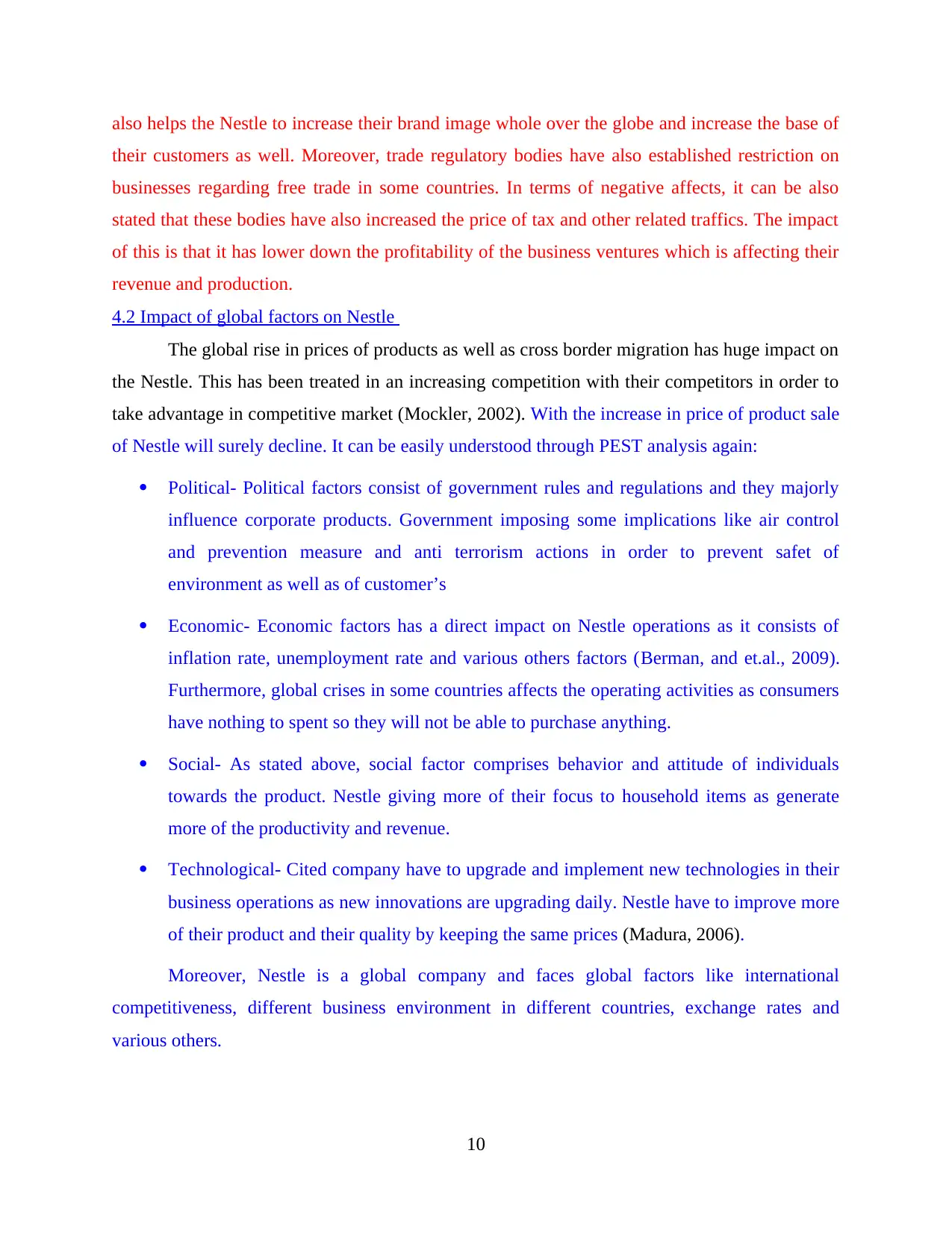
also helps the Nestle to increase their brand image whole over the globe and increase the base of
their customers as well. Moreover, trade regulatory bodies have also established restriction on
businesses regarding free trade in some countries. In terms of negative affects, it can be also
stated that these bodies have also increased the price of tax and other related traffics. The impact
of this is that it has lower down the profitability of the business ventures which is affecting their
revenue and production.
4.2 Impact of global factors on Nestle
The global rise in prices of products as well as cross border migration has huge impact on
the Nestle. This has been treated in an increasing competition with their competitors in order to
take advantage in competitive market (Mockler, 2002). With the increase in price of product sale
of Nestle will surely decline. It can be easily understood through PEST analysis again:
Political- Political factors consist of government rules and regulations and they majorly
influence corporate products. Government imposing some implications like air control
and prevention measure and anti terrorism actions in order to prevent safet of
environment as well as of customer’s
Economic- Economic factors has a direct impact on Nestle operations as it consists of
inflation rate, unemployment rate and various others factors (Berman, and et.al., 2009).
Furthermore, global crises in some countries affects the operating activities as consumers
have nothing to spent so they will not be able to purchase anything.
Social- As stated above, social factor comprises behavior and attitude of individuals
towards the product. Nestle giving more of their focus to household items as generate
more of the productivity and revenue.
Technological- Cited company have to upgrade and implement new technologies in their
business operations as new innovations are upgrading daily. Nestle have to improve more
of their product and their quality by keeping the same prices (Madura, 2006).
Moreover, Nestle is a global company and faces global factors like international
competitiveness, different business environment in different countries, exchange rates and
various others.
10
their customers as well. Moreover, trade regulatory bodies have also established restriction on
businesses regarding free trade in some countries. In terms of negative affects, it can be also
stated that these bodies have also increased the price of tax and other related traffics. The impact
of this is that it has lower down the profitability of the business ventures which is affecting their
revenue and production.
4.2 Impact of global factors on Nestle
The global rise in prices of products as well as cross border migration has huge impact on
the Nestle. This has been treated in an increasing competition with their competitors in order to
take advantage in competitive market (Mockler, 2002). With the increase in price of product sale
of Nestle will surely decline. It can be easily understood through PEST analysis again:
Political- Political factors consist of government rules and regulations and they majorly
influence corporate products. Government imposing some implications like air control
and prevention measure and anti terrorism actions in order to prevent safet of
environment as well as of customer’s
Economic- Economic factors has a direct impact on Nestle operations as it consists of
inflation rate, unemployment rate and various others factors (Berman, and et.al., 2009).
Furthermore, global crises in some countries affects the operating activities as consumers
have nothing to spent so they will not be able to purchase anything.
Social- As stated above, social factor comprises behavior and attitude of individuals
towards the product. Nestle giving more of their focus to household items as generate
more of the productivity and revenue.
Technological- Cited company have to upgrade and implement new technologies in their
business operations as new innovations are upgrading daily. Nestle have to improve more
of their product and their quality by keeping the same prices (Madura, 2006).
Moreover, Nestle is a global company and faces global factors like international
competitiveness, different business environment in different countries, exchange rates and
various others.
10
Paraphrase This Document
Need a fresh take? Get an instant paraphrase of this document with our AI Paraphraser

4.3 Impact of European Union on Nestle
European Union (EU) consists of various rules and regulations which countries have to
maintain to seek and perform well in operating countries. Some major policies which are
considered by EU are employment, regional, educational and training, international, etc. The
European union policies has huge impact on the Nestle as it includes taxation and employment
policy (Capon, 2009). Moreover, corporate have to follow all the policies in order to function
efficiently and effectively. However, if Nestle have breached any of the policies made by EU
then it would be treated as a common law of violation of agreement.
Furthermore, corporate have various products and they are performing with best of their
performance. Due to this, corporate is able to maintain their large customer base and are building
up new customers on daily basis. This union is considered as single largest market in the world
and it states that all members of EU can freely conduct their business activities and trade
practices with the other members of the country as well. It consists of some policies and
procedure as well which member countries have to maintain in order to seek and perform well in
operating nations. Some major policies taken by EU are in relation with the employment,
regional, educational and training, inflation, etc.
CONCLUSION
From the above report it has been concluded that how Nestle meets with objective of
various stakeholders in order to gain competitive advantage in market place. Impact of Fiscal and
Monetary policy have been discussed in context of Nestle and also the impact of social welfare
and industrial policy initiatives on the organization. Further, this report determines pricing and
output decisions of Nestle and how it responses on different market forces and it also focuses on
shaping the behavior of entity by considering business and cultural factors into consideration.
11
European Union (EU) consists of various rules and regulations which countries have to
maintain to seek and perform well in operating countries. Some major policies which are
considered by EU are employment, regional, educational and training, international, etc. The
European union policies has huge impact on the Nestle as it includes taxation and employment
policy (Capon, 2009). Moreover, corporate have to follow all the policies in order to function
efficiently and effectively. However, if Nestle have breached any of the policies made by EU
then it would be treated as a common law of violation of agreement.
Furthermore, corporate have various products and they are performing with best of their
performance. Due to this, corporate is able to maintain their large customer base and are building
up new customers on daily basis. This union is considered as single largest market in the world
and it states that all members of EU can freely conduct their business activities and trade
practices with the other members of the country as well. It consists of some policies and
procedure as well which member countries have to maintain in order to seek and perform well in
operating nations. Some major policies taken by EU are in relation with the employment,
regional, educational and training, inflation, etc.
CONCLUSION
From the above report it has been concluded that how Nestle meets with objective of
various stakeholders in order to gain competitive advantage in market place. Impact of Fiscal and
Monetary policy have been discussed in context of Nestle and also the impact of social welfare
and industrial policy initiatives on the organization. Further, this report determines pricing and
output decisions of Nestle and how it responses on different market forces and it also focuses on
shaping the behavior of entity by considering business and cultural factors into consideration.
11
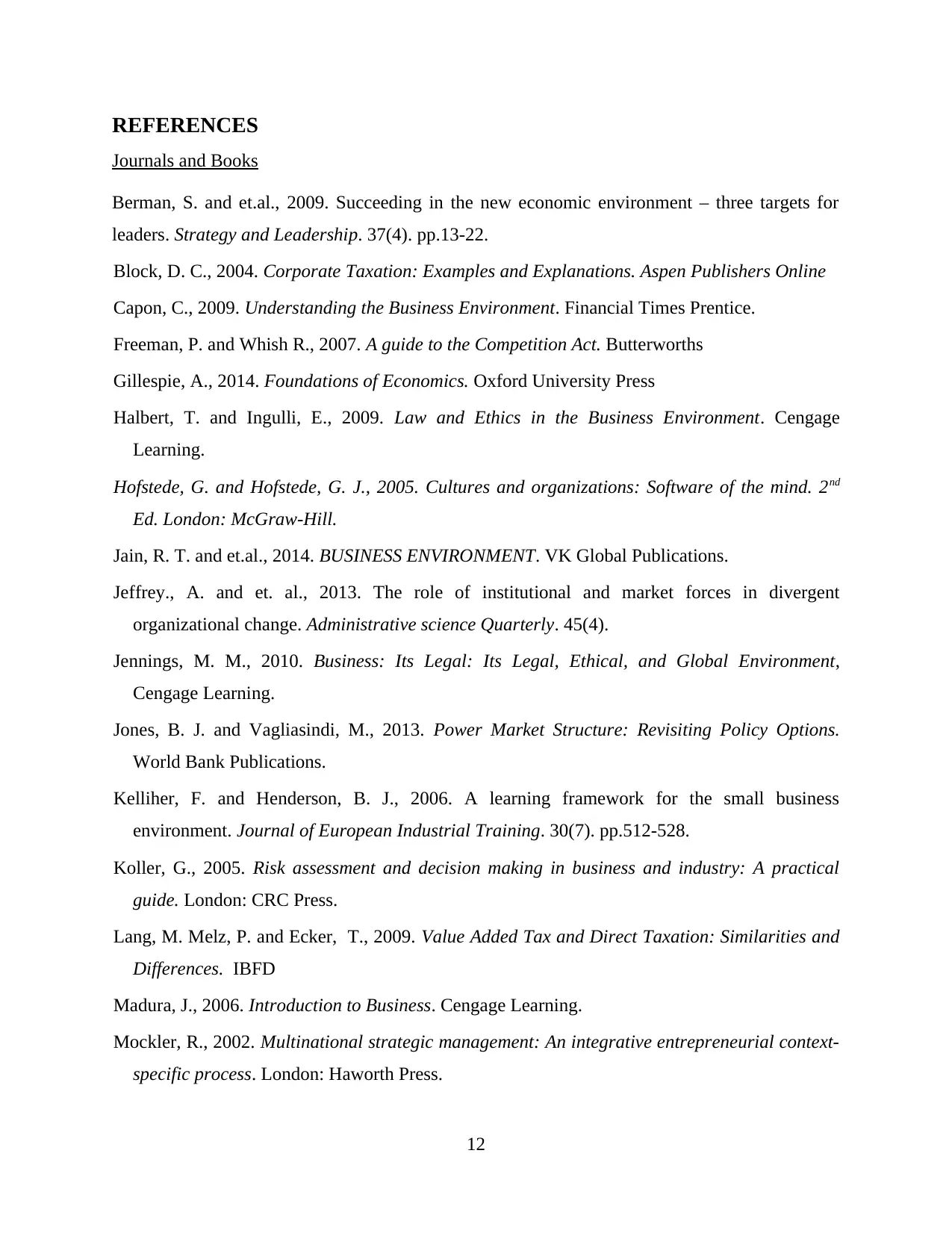
REFERENCES
Journals and Books
Berman, S. and et.al., 2009. Succeeding in the new economic environment – three targets for
leaders. Strategy and Leadership. 37(4). pp.13-22.
Block, D. C., 2004. Corporate Taxation: Examples and Explanations. Aspen Publishers Online
Capon, C., 2009. Understanding the Business Environment. Financial Times Prentice.
Freeman, P. and Whish R., 2007. A guide to the Competition Act. Butterworths
Gillespie, A., 2014. Foundations of Economics. Oxford University Press
Halbert, T. and Ingulli, E., 2009. Law and Ethics in the Business Environment. Cengage
Learning.
Hofstede, G. and Hofstede, G. J., 2005. Cultures and organizations: Software of the mind. 2nd
Ed. London: McGraw-Hill.
Jain, R. T. and et.al., 2014. BUSINESS ENVIRONMENT. VK Global Publications.
Jeffrey., A. and et. al., 2013. The role of institutional and market forces in divergent
organizational change. Administrative science Quarterly. 45(4).
Jennings, M. M., 2010. Business: Its Legal: Its Legal, Ethical, and Global Environment,
Cengage Learning.
Jones, B. J. and Vagliasindi, M., 2013. Power Market Structure: Revisiting Policy Options.
World Bank Publications.
Kelliher, F. and Henderson, B. J., 2006. A learning framework for the small business
environment. Journal of European Industrial Training. 30(7). pp.512-528.
Koller, G., 2005. Risk assessment and decision making in business and industry: A practical
guide. London: CRC Press.
Lang, M. Melz, P. and Ecker, T., 2009. Value Added Tax and Direct Taxation: Similarities and
Differences. IBFD
Madura, J., 2006. Introduction to Business. Cengage Learning.
Mockler, R., 2002. Multinational strategic management: An integrative entrepreneurial context-
specific process. London: Haworth Press.
12
Journals and Books
Berman, S. and et.al., 2009. Succeeding in the new economic environment – three targets for
leaders. Strategy and Leadership. 37(4). pp.13-22.
Block, D. C., 2004. Corporate Taxation: Examples and Explanations. Aspen Publishers Online
Capon, C., 2009. Understanding the Business Environment. Financial Times Prentice.
Freeman, P. and Whish R., 2007. A guide to the Competition Act. Butterworths
Gillespie, A., 2014. Foundations of Economics. Oxford University Press
Halbert, T. and Ingulli, E., 2009. Law and Ethics in the Business Environment. Cengage
Learning.
Hofstede, G. and Hofstede, G. J., 2005. Cultures and organizations: Software of the mind. 2nd
Ed. London: McGraw-Hill.
Jain, R. T. and et.al., 2014. BUSINESS ENVIRONMENT. VK Global Publications.
Jeffrey., A. and et. al., 2013. The role of institutional and market forces in divergent
organizational change. Administrative science Quarterly. 45(4).
Jennings, M. M., 2010. Business: Its Legal: Its Legal, Ethical, and Global Environment,
Cengage Learning.
Jones, B. J. and Vagliasindi, M., 2013. Power Market Structure: Revisiting Policy Options.
World Bank Publications.
Kelliher, F. and Henderson, B. J., 2006. A learning framework for the small business
environment. Journal of European Industrial Training. 30(7). pp.512-528.
Koller, G., 2005. Risk assessment and decision making in business and industry: A practical
guide. London: CRC Press.
Lang, M. Melz, P. and Ecker, T., 2009. Value Added Tax and Direct Taxation: Similarities and
Differences. IBFD
Madura, J., 2006. Introduction to Business. Cengage Learning.
Mockler, R., 2002. Multinational strategic management: An integrative entrepreneurial context-
specific process. London: Haworth Press.
12
⊘ This is a preview!⊘
Do you want full access?
Subscribe today to unlock all pages.

Trusted by 1+ million students worldwide
1 out of 13
Related Documents
Your All-in-One AI-Powered Toolkit for Academic Success.
+13062052269
info@desklib.com
Available 24*7 on WhatsApp / Email
![[object Object]](/_next/static/media/star-bottom.7253800d.svg)
Unlock your academic potential
Copyright © 2020–2025 A2Z Services. All Rights Reserved. Developed and managed by ZUCOL.





